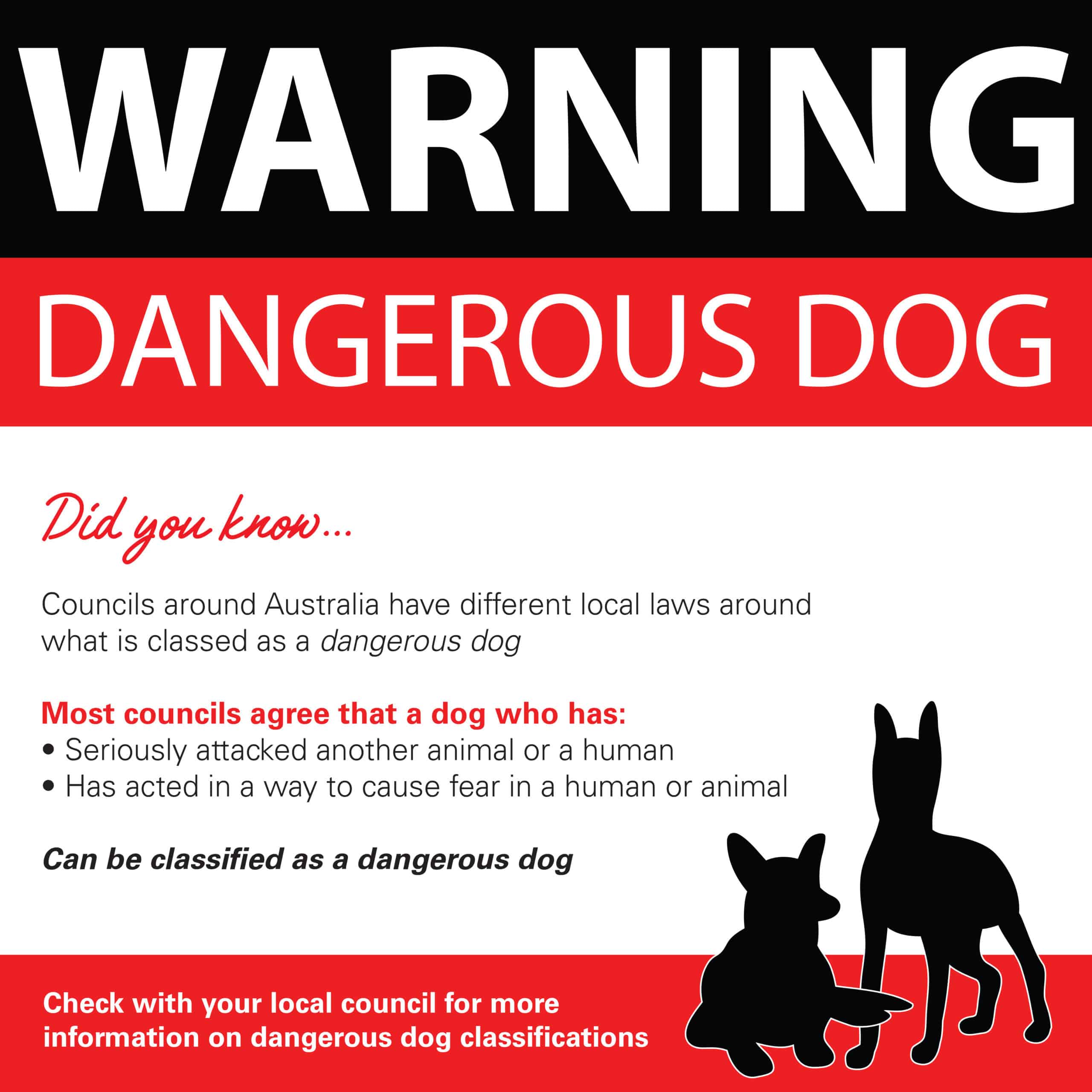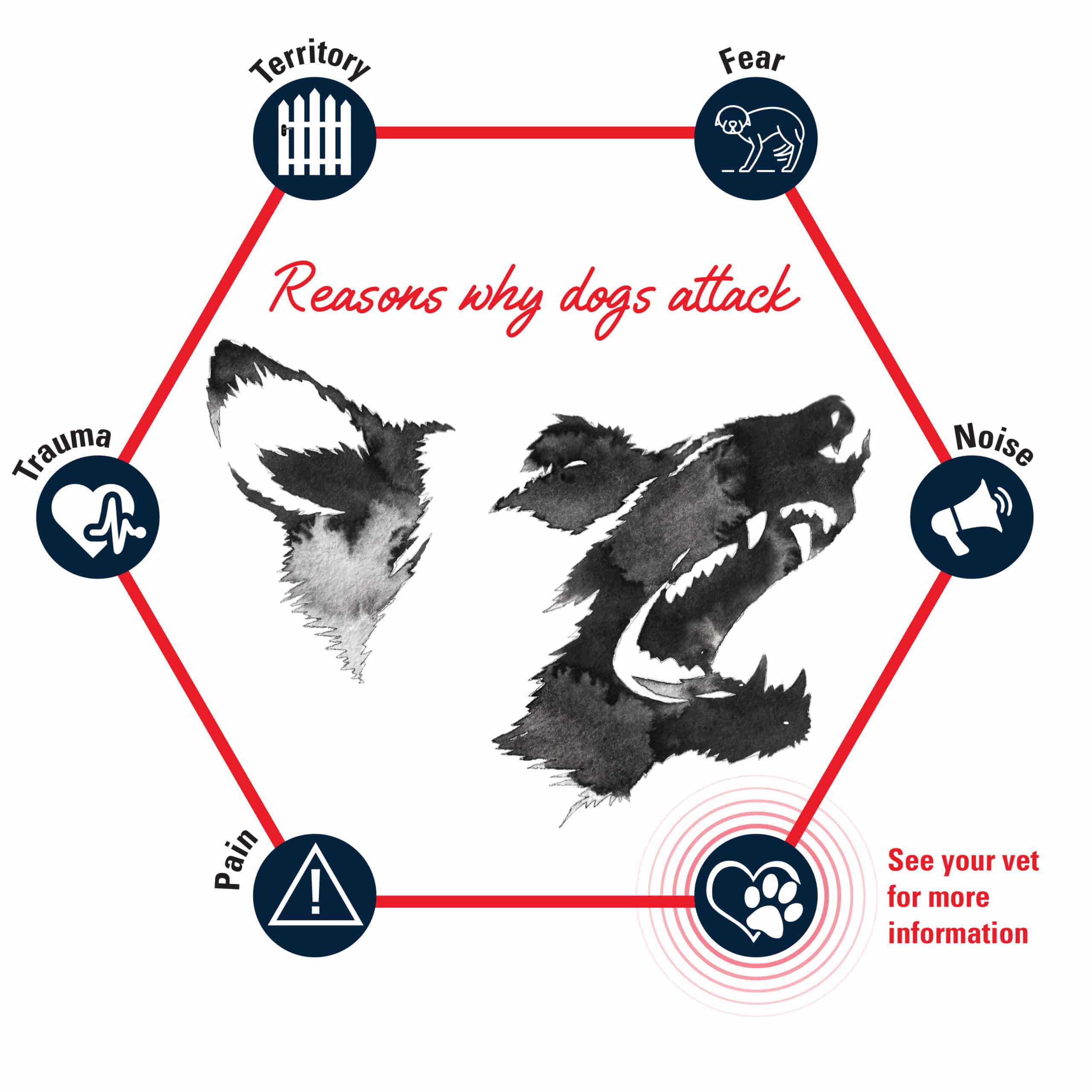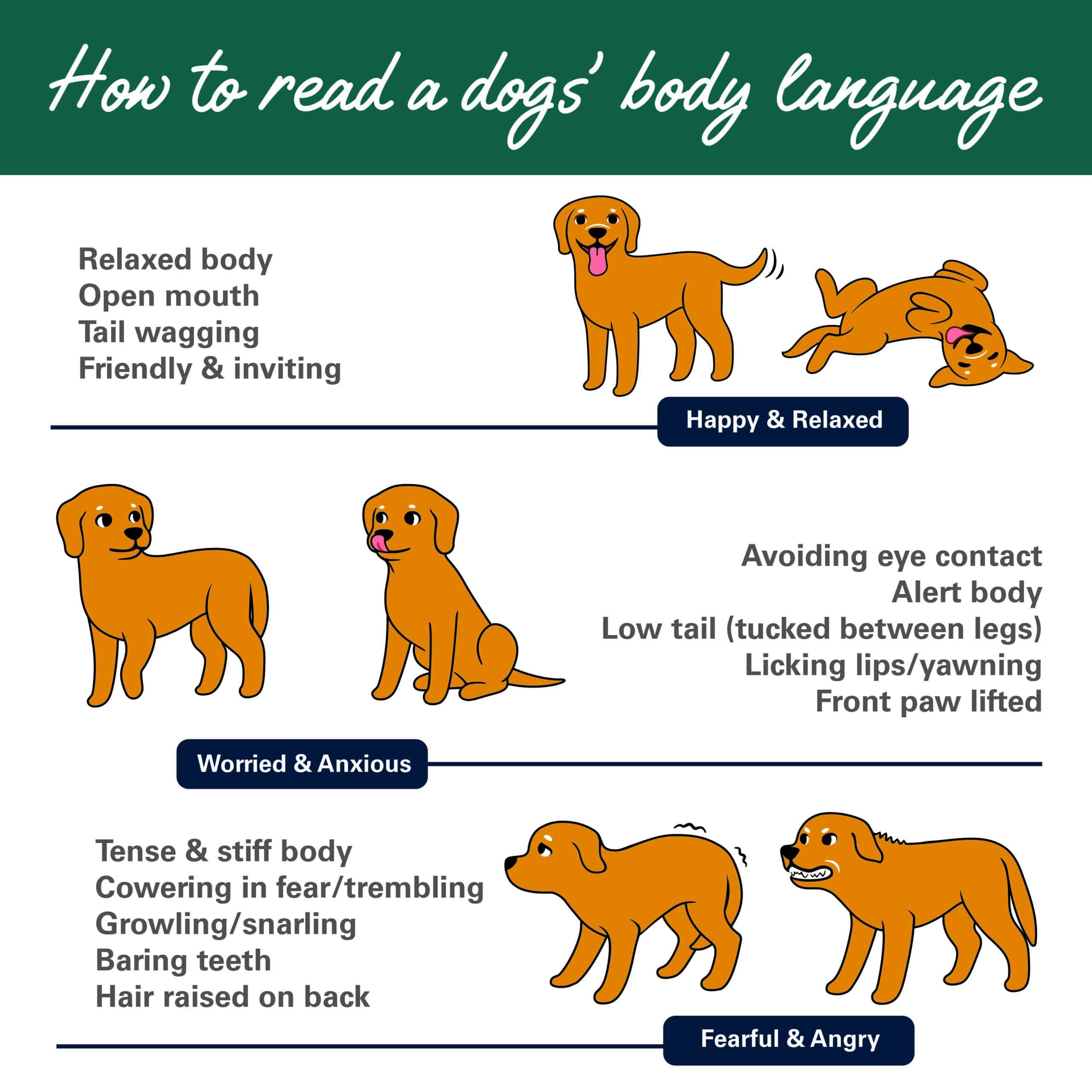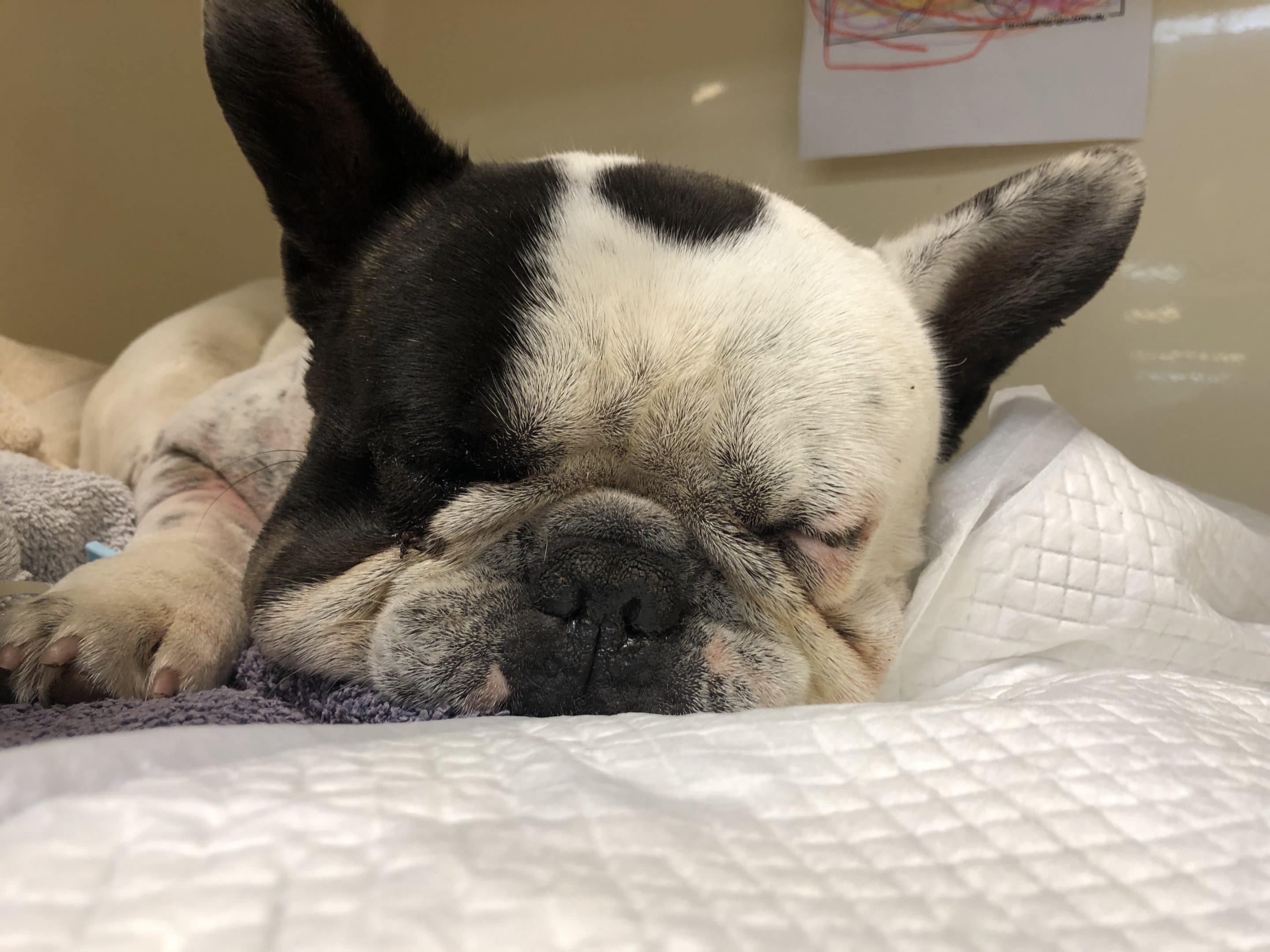Dog attacks are scary and traumatic for both pet owners and their pets. It is a little know fact that a dog attack is likely to cause significant damage under the surface of a wound. For this reason, it is important to know what to do when a dog attack occurs.
What you’ll learn
- What is classed as a dog attack?
- Why dogs attack other dogs and humans
- Signs of an aggressive dog
- What you can do if a dog attacks another dog
- What you should do after a dog attack
- Treatment at the vet for dogs who have been in a dog attack
- Who is responsible for the vet bill after a dog attack
- How to prevent dog attacks
- Can a dog be traumatised after a dog attack
- What breeds are most likely to be in a dog attack
- Stories about dog attacks
What is classed as a dog attack
Aggression in animals is a natural instinct – however, there are ways to manage aggressive behaviour. If you are worried your dog is showing signs of aggressive behaviour, talk to your local vet about the steps you can take to prevent your dog from attacking other animals.
Councils around Australia have different local laws surrounding what is classed as a dangerous dog, however, most councils agree that a dog who has:
- Seriously attacked another animal or a human
- Has acted in a way to cause fear in a human or animal
Will generally be classified as a dangerous dog. It is your responsibility as a dog owner to comply with the requirements imposed by your local council to contain and manage your pet at all times, particularly when your dog is classified as a dangerous dog or if your dog is under investigation for classification.
There may also be differing registration fees imposed by your local council if your dog has been found to be a dangerous dog. Be sure to check your local council website or contact your local council if you are planning on adopting a dog to check which breeds are prohibited from being owned, as in most cases these dogs will be seized by the council and euthanised according to that council’s local law requirements.
Why dogs attack other dogs and humans
Although there are a variety of reasons dogs may attack other dogs and humans, there are some animalistic instincts that may lead to aggressive behaviour in dogs:
- Territorial behaviour towards objects, spaces, people, and/or food
- Fear of other humans, objects, spaces
- The presence of trauma leading to anxiety and fear in dogs
- Noise and unusual human/animal activity within the household
- An animal who is in pain from injury, illness, or disease
While it can be obvious that a dog may possess aggressive tendencies (see below for signs of an aggressive dog), it is not always obvious and can be due to a mix of different reasons (more information about this here).
Signs of an aggressive dog
Dogs give warning signs that they are uncomfortable in their behaviour and body language.
Territorial behaviour is the marked change in a dog’s behaviour, seen when another human or animal approaches an object, space, person, or food item belonging to the dog. Dogs are naturally territorial animals and will defend and protect their property from other humans or animals. Territorial behaviour can include snarling, raised body hair, tense body, growling, barking, and mouthing/nipping.
Fear can lead a dog to exhibit unfavourable behaviour, but in reality this is the dog’s instinctual way of defending itself from harm. Fear can come from a place of previous trauma, or it can be an altogether new experience for the dog. Unusual objects, people, noises, and spaces can be overwhelming, especially if they are not part of that dog’s common daily routine.
Signs that a dog may be fearful of objects, people, spaces, or noises include backing away, hiding, retreating, snarling, growling, whimpering, tense body language, raised hair, scratching, biting, and pouncing.
Previous trauma can take shape in many forms but can include such things as being the victim of a dog attack, violent or aggressive behaviour from another human or animal, being in a particularly noisy or stressful situation, or even witnessing a traumatic event take place in the household.
The signs that a dog has experienced trauma in the past may be difficult to uncover at first, especially if the dog has been adopted from another family and their past has not been disclosed to you. Look for signs such as cowering and hiding as they may be warnings that the dog may be feeling uncomfortable.
It is important to note when observing a dog’s body language that their behaviour is not necessarily a sign of impending aggression – that is to say, the dog may not attack at that moment in time. It is a sign however that you should discuss the behaviour with your local vet; training may be necessary to correct the behaviour, or even making some changes to the dogs environment at home.
What you can do if a dog attacks another dog
It is a little known fact that the majority of dog attacks that occur in a public place actually take place on the footpath in front of the dog’s home; and you’d be right to mark this as territorial behaviour (see above). The Victoria Department of Agriculture predicts that 80% of dog attacks would be prevented by properly confining dogs to their property, as a large number of cases involve a dog escaping from an unsecured yard.
You should always be on alert and prepared for the instance of a dog escaping their yard (especially while out for a walk with your dog) and know what to do if one does. We’ve written a whole blog on how to stop a dog fight, so that you know the in’s and out’s of what to do (and what not to do).
There are preventative measures you can take, but what can you do if you see a dog attack, or if your dog is the victim or perpetrator of a dog attack? There are three things to remember:
- Do not try to break up the dog fight with your bare hands. Pour/tip water from a water bottle over the dogs heads or use a hose to wet their body (being careful not to point the hose at the dogs’ mouth as this could cause drowning) to shock the dogs into breaking apart.
X-ray of a dog owner’s hand showing fractures from trying to break up a dog fight
- Keep calm with the other dog owner – you will both be in shock; swap details if it is safe to do so and focus on each other’s and your pet’s health.
- Have your dog seen by a vet immediately. Wounds caused by a dog bite are described as ‘the tip of the iceberg’ (read more here). You want to make sure that your dog doesn’t have any internal injuries from the attack.
Read more on how to stop dogs from fighting with each other here.
What you should do after a dog attack
As per above, you will need to have your dog checked over after a dog attack – not all bite wounds tear the skin, but they can still cause significant internal crushing damage. Even small punctures can mean significant trauma. It is for this reason that you will need to take your pet to the vet immediately.
It is a little known fact that dogs produce over half the amount of pounds of pressure per square inch (PSI) than humans: a human bite averages 120-140 PSI, while a dog bite averages between 230-320 PSI. For comparative purposes, a lion’s bite force ranges from 650 PSI+. This is why vets recommend having your pet seen immediately if they have been a victim of a dog attack, as the amount of pressure from the jaw can lead to significant damage underneath the skins surface, known as ‘the iceberg effect’. Read more about ‘the iceberg effect’ here.
It may be tempting to enter into an argument with the owner of the other dog about who is at fault (see below – who is responsible for the vet bill), but our veterinarians would urge all pet owners to keep calm and work together to deal with the ramifications of a dog attack. Dog fights are a very stressful situation for all owners involved, but the priority should always be to ensure any person or animal harmed during a dog fight sees a medical professional as quickly as possible.
After ensuring that the dogs are separated and far from reach from each other, if it is safe to do so, swap phone numbers, names and email addresses and agree to discuss the ramifications of the dog fight at a more suitable time. If the owner is aggressive or defensive consider your own safety, take note of any identifying features of the owner to take up with your local authorities at a later time and get your pet to the vet immediately.
If you yourself have been harmed during the dog attack, call a friend or family member and have them take your dog to the vet while you seek urgent medical attention for yourself. It is recommended to go straight to the hospital, as the iceberg effect not only happens to dogs – it also happens to people.
Treatment at the vet for dogs who have been in a dog attack
When you arrive at the vet clinic, it is important to let the receptionist know that your dog has been involved in a dog attack. The receptionist may segregate your dog from other dogs at this point in case the dog lashes out from fear or pain at other animals or people in the waiting room.
The vet will perform a physical exam on your pet and may need to start life saving interventions immediately if there is significant trauma. Pain relief is administered to your dog alongside antibiotics to prevent infection from bacteria entering the body through wound sites.
Surgery is usually required so the extent of the injuries can be assessed, the wounds debrided and decontaminated and closed if possible to ensure a good recovery for the pet. Sometimes repeat surgeries are required and sometimes drains are placed temporarily to help decontaminate the wound and reduce the ‘dead space’ (space creating by the pet’s jaw shaking the layers apart).
If the vet is concerned about internal injuries, imaging such as x-rays and ultrasound maybe performed.
Puncture wounds can go as deep as the abdomen and lead to organ damage and internal bleeding. Emergency abdominal surgery may be required to repair the injury.
Puncture wounds can also enter the chest and can extend deep enough to puncture the lungs, leading to bleeding or air leaking into the chest cavity. Emergency open chest surgery may be required to repair these injuries.
The vet may also conduct blood tests. In severe dog bite wounds especially involving internal injuries, a blood transfusion may be required.
Animal Emergency Service patient, Shai who was attacked by a dog, after receiving treatment
Who is responsible for the vet bill after a dog attack
If your dog requires surgery, x-rays, ultrasounds, medications and antibiotics, it is likely that the vet bill will be high. These are expensive medical procedures and treatments to perform.
If your dog is on the receiving end of a dog attack it may seem unfair for you to fit the bill for the cost of medical treatment – however it is not your veterinarian’s place to get involved in any dispute about payment for treatment. The responsibility for the vet bill falls with the owner of the dog that has been treated.
There are laws that apply in the different states of Australia around the liability of a dog attack, and in Queensland a different legal system is in place that makes it difficult to prove that a dog owner is responsible. In all other states of Australia where an owner’s dog attacks another; that owner is always responsible.
Your veterinarian will always be supportive in your decisions when it comes to medical treatment involving your dog and those decisions will always be yours to make with the guidance given by your vet. While medical expenses can potentially lead to a stressful situation for your hip pocket, don’t be tempted to try to ‘skip the bill’. Always pay for vet treatment and obtain any receipts and photos of surgeries/dog wounds, x-rays and ultrasound results – you can take these to a solicitor and seek legal advice regarding your right to reimbursement from the offending dog’s owner.
How to prevent dog attacks
Dog owners can take many preventative measures both at home and while out and about to avoid the instance of being the perpetrator or victim of a dog attack.
Things you can do at home include keeping a close eye on food and treats and if you have more than one dog, making sure they are fed separately and limiting access to shared food or toys is always a good idea. If your dogs will be overstimulated by a noisy environment such as playing children, music, or even extra guests, ensure both dogs have a quiet space to retreat to (preferably spaces away from each other).
Steps you can take while out and about include considering new walking routes first on your own, before bringing along your pooch – to assess them for unconfined dogs or inadequate fencing/enclosures. Always avoid giving your dog pet treats or food while you’re out (save it for when they get home!) and don’t introduce your dog to a large number of dogs at once.
Learning how to approach a dog safely is always a good skill to have, as well as being able to read their body language. Read more about how to approach a dog safely (and read their body language) and practical measures you can take both in and out of the home here.
Can a dog be traumatised after a dog attack
In short, the answer is yes, a dog can be traumatised after a dog attack. Alongside the physical scars of the wounds they have gained, the dog may be emotionally scarred from the traumatic event, and you will need to be on the lookout for behaviour that might indicate your dog has been affected in this way.
Your dog may experience a range of emotions immediately after the attack – shock is a common symptom and you may see your pet physically shaking from the increased adrenaline pumping through their system. Even weeks later, you may also notice that when you come across the same spot where the incident occurred, or even just in the presence of other dogs, that your pet’s behaviour is considerably different. Signs that your dog is suffering emotional trauma include avoiding playing and interacting with other dogs, or even defensive behaviour towards other dogs such as snarling, the arching of the back, increased alertness and hair standing up on the dogs’ back.
If your dog has faced the unfortunate instance of being involved in a dog attack, be on the lookout for these signs and be sure to seek veterinary help if you find your dog displaying these behaviours. Addressing your dog’s emotional well-being may include working with a behavioural specialist to retrain your dog’s behaviour in response to emotional or situational triggers.
It is important that you seek specialist assistance, as if left untreated, your dog may increasingly exhibit these negative behaviours and become a danger to themselves and other animals/humans. A behavioural specialist will be able to work with you to reinforce positive behaviours and rehabilitate their interactions.
What breeds are most likely to be in a dog attack
It is important to remember that while some breeds are classified as dangerous dogs with local councils in Australia, it is the deed of displaying aggressive behaviour towards other animals or humans that makes the dog more likely to attack, regardless of breed.
Over the many years of saving pet’s lives, Animal Emergency Service veterinarians have seen dogs of all sizes, shapes and breeds come through their doors both from being a victim and perpetrator of a dog attack.
There is evidence that local laws controlling the ownership of certain breeds to reduce the incidence of dog attacks is not working as a preventative measure. A paper released by the Australian Veterinary Association (AVA) sites that breed-specific legislation put in place to reduce the frequency of dog bites has failed as a method of prevention.
Further to this, the AVA classifies the factors of whether a dog has a tendency to attack as all of the following factors, rather than just one alone: heredity (genes, breed), early experience, socialisation and training, health (physical and psychological) and victim behaviour. This is not to say that genetic predispositions aren’t an important factor – they are, however environmental and learning factors are critical in determining whether a dog is likely to be more dangerous or more likely to be involved in a dog attack.
Your local council does have the power to euthanise animals that are classified as dangerous and we encourage checking with them to see what this entails. Before purchasing your dog, consider researching the breed with both your local council and online resources. As part of responsible pet ownership, you as the owner will always be responsible for your dog’s actions, and our vets recommend being as prepared as possible before taking the plunge and purchasing a pet.
Councils may have a list of restricted dog breeds within their jurisdiction, and it is important that you follow these guidelines. If you are in possession of a classified dangerous breed, the council will seize the dog and humanely euthanise them under local law. Check your local council’s website for a list of classified dangerous breed dogs.
Stories about dog attacks
Dog attacks are the most common emergency appearing in all four of Animal Emergency Service’s hospitals. Our team are passionate about spreading awareness of the information above and the stories below in the hope that the information influences dog owners to be vigilant and wary in situations with their dogs.
Gizmo: When play fights go wrong
One year old Gizmo arrived to Animal Emergency Service after a play fight with two other household dogs turned ugly. After stabilising Gizmo he was admitted to the Pet Intensive Care Unit and placed on oxygen, with vets concerned he had inhaled fluid or foreign objects into his lungs. Gizmo’s story is an example of how important it is to get to the vet – what you can visibly see is just the surface of the injuries underneath the skin and fur. Read more about Gizmo’s story and recovery here.
Harris’ tail of survival (and why dog attack wounds are worse than they appear)
Harris the 6-year-old poodle x was out on a walk with his family on a lead when another dog playing ball ran up behind him and bit him on the back. Upon inspection, his owners couldn’t find any serious wounds or bleeding, but as he was in pain they rushed him to Animal Emergency Service Tanawha on the Sunshine Coast. As the vets examined poor Harris they soon realised that the dog bite had punctured the chest cavity, causing several broken ribs. Read about Harris’ survival of this horrific dog attack.
If your dog has been in a dog attack, contact your closest Animal Emergency Service hospital or your local vet immediately.








